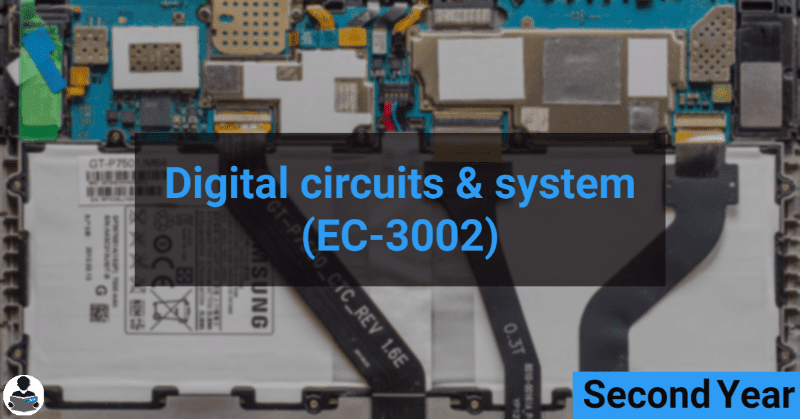Digital Circuits & System (EC-3002)

rgpv bhopal, diploma, rgpv syllabus, rgpv time table, how to get transcript from rgpv, rgpvonline,rgpv question paper, rgpv online question paper, rgpv admit card, rgpv papers, rgpv scheme
RGPV notes CBGS Bachelor of engineering
Course Objective
To learn the basic methods for the design of digital circuits and provide the fundamental Concepts used in the design
of digital systems.
To introduce basic postulates of Boolean algebra and shows the correlation between
Boolean expressions
To introduce the methods for simplifying Boolean expressions
To outline the formal procedures for the analysis and design of combinational circuits andsequential circuits
To introduce the concept of memories and programmable logic devices.
To illustrate the concept of synchronous and asynchronous sequential circuits
Syllabus
UNIT 1:
Review of Logic gates and binary operations- AND, OR, NOT, NAND, NOR, Exclusive–OR and Exclusive–
NOR Implementations of Logic Functions using gates, NAND–NOR implementations – Multi level gate
implementations- Multi output gate implementations.Introduction to number systems and binary operations.
Boolean postulates and laws – De-Morgan’s Theorem - Principle of Duality, Boolean function, Canonical and
standard forms,Minimization of Boolean functions, Minterm,Maxterm, Sum of Products (SOP), Product of Sums
(POS),Karnaugh map Minimization, Don’t care conditions, Quine-McCluskey method of minimization.
UNIT 2:
Combinational logic circuits:Half adder – Full Adder – Half subtractor - Full subtractor– Parallelbinary adder,
parallel binary Subtractor – Fast Adder - Carry Look Ahead adder– Serial. Adder/Subtractor - BCD adder – Binary
Multiplier – Binary Divider - Multiplexer/De-multiplexer – decoder - encoder – parity checker – parity generators –
codeconverters - Magnitude Comparator.
UNIT 3:
Sequential logic circuits:Latches, Flip-flops - SR, JK, D, T, and Master-Slave, Characteristic table and equation–
Application table – Edge triggering – Level Triggering – Realization of one flip flopusing other flip flops – serial
adder/subtractor.
UNIT 4:
Registers and Counters: Asynchronous Ripple or serial counter. Asynchronous Up/Down counter - Synchronous
counters – Synchronous Up/Downcounters – Programmable counters – Design of Synchronous counters: state
diagram-State table –State minimization –State assignment - Excitation table and maps-Circuit. Implementation -
Modulo–n counter, Registers – shift registers - Universal shift registers. Shift register counters – Ring counter –
Shift counters - Sequence generators.
UNIT 5:
Logic Families:Introduction to different logic families and their characteristics ,RTL,DTL,TTL, ECL, IIL,TTL
inverter – circuit description and operation, CMOS inverter – circuit description and operation, other TTL and
CMOS gates,
Memories – ROM - ROM organization - PROM – EPROM – EEPROM –EAPROM, RAM – RAM organization
Static RAM, Dynamic RAM, Programmable Logic Array (PLA) - Programmable Array Logic (PAL)
NOTES
- Unit 1
- Unit 2
- Unit 3
- Unit 4
- Unit 5
Course outcome
Students who are successful in this class will demonstrate at least the abilities:
1. To introduce the concepts and techniques associated with the number systems and codes. To minimize the logical
expressions using Boolean postulates.
2. To design various combinational and sequential circuits.
TEXT BOOKS
1. M. Morris Mano, Digital Design, 3rd Edition, Prentice Hall of India Pvt. Ltd., 2003 Pearson Education
(Singapore) Pvt. Ltd., New Delhi, 2003.
2. Donald P.Leach and Albert Paul Malvino, Digital Principles and Applications, 6thEdition, TMH, 2003.
3. http://www.nptelvideos.in/2012/12/digital-circuits-and-systems.html
REFERENCES
1. Anil K. Maini, Digital electronics Principles and Integrated circuits Wiley India Pvt. Ltd.
2. Anandkumar- fundamental of digital circuit. 3rd edition. PHI
3. John. F. Wakerly, Digital Design, Principles and Practices, Pearson Prentice Hall
4. John.M Yarbrough, Digital Logic Applications and Design, Thomson Learning, 2002.
5. Comer: Digital Logic & State Machine Design, Oxford Publication.
6. Donald D.Givone, Digital Principles and Design, TMH, 2003.
7. Ghosal- Digital electyronis, cengage learning.
Graphical Programming using Lab
1. To verify the truth table of all basic logic gates and to implement all gate using universal gate.
2. Design of 4 bit Adders (CLA, CSA, CMA, Parallel adders)
3. Design of Binary Subtractors
4. Design of Encoder (8X3), Encoder(3X8)
5. Design of Multiplexer (8X1), and De-multiplexer (1X8)
6. Design of code converters & Comparator
7. Design of FF (SR, D, T, JK, and Master Slave with delays)
8. Design of registers using latches and flip-flops



